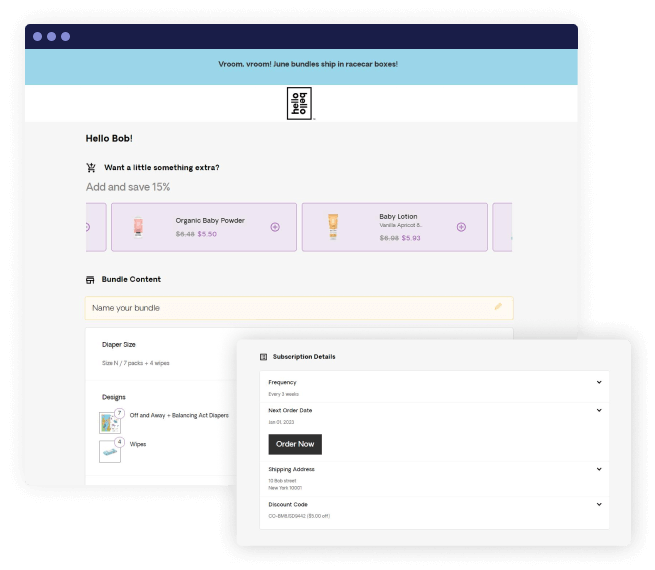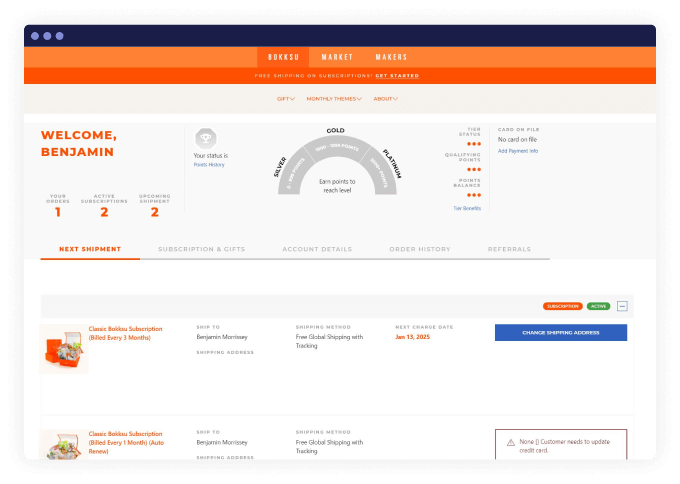Average order value (AOV) is one of the most important performance metrics for any ecommerce site or retail store. It measures the average dollar amount a customer spends in a single transaction with you—and, along with churn rate, lifetime value (LTV), and customer acquisition cost (CAC), it can give you key insights into the health of your business.
To calculate average order value for your business, it’s relatively straightforward: Simply divide your revenue by your total number of orders. Your strategies to increase your average order value, however, can go in a multitude of different directions. Here, we’ll dive into a few key marketing efforts that top-performing ecommerce businesses use to encourage customers to purchase more per order, strengthening their customer relationships in the process.
Strategies to increase AOV for your online store
To increase average order value for your business, it’s essential to add more value for your customers. This value can come in many forms, but often contains some combination of the following elements:
- Personalization: making sure each individual customer is able to find their perfect product offerings
- Flexibility: making sure customers can adjust their orders to suit their specific schedule or lifestyle
- Pricing strategy: making sure customers feel like they are getting a great deal with your product offerings
Cross-selling & upselling
Cross-selling and upselling are separate but related sales tactics. Both involve making targeted product recommendations to your customers to increase average order value, but use slightly different approaches.
In cross-selling, brands recommend related products or services to add on to a customer’s original purchase. For example, in the ecommerce world, a subscription coffee company might cross-sell complementary products to their customers, such as a pack of specialty coffee filters or a French press. In this case, these cross-sells are one-time purchases that help the customer get more out of their original coffee subscription while increasing the value of their order.
In upselling, meanwhile, brands make personalized recommendations to persuade customers to purchase a more expensive product or service—one with a higher perceived value. For example, a streaming service might upsell a premium subscription without commercials to its existing customers, offering them the chance to upgrade for a slightly higher price.

When cross-selling and upselling, an online business may choose to offer bundles of products that are frequently bought together on their ecommerce site. This might include bundle deals or discounts to entice customers to purchase the larger assortment of items. Brands can also unbundle a bundle and offer each product for individual purchase. By making product offerings flexible in this way, customers are encouraged to add on more to their original purchase in whatever way works best for them.
Personalization is key to effective cross-selling and upselling—typically, customers spend more money when they feel seen and understood. These recommendations have the power to demonstrate to your shoppers that you understand their needs, which can not only bring in more revenue for your business, but also create more loyal customers and improve your customer retention. For subscription merchants, whose business model depends on repeat sales, this is particularly important.
Offer free shipping & other discounts
Discounts and other financial incentives can be another highly effective strategy for increasing AOV and encouraging customers to purchase more. Some ecommerce sites may choose to do this by providing a discount once a certain threshold or minimum order value is met. This minimum purchase amount can also increase customers’ perceived value of their order. Discounts can also come in the form of a free shipping threshold or reduced price shipping.
Online retailers can also offer post-purchase promotions, such as a coupon code or a gift card, which can be used toward future purchases once an order minimum is reached. This encourages an extension of the customer journey beyond a first purchase.
Create a customer loyalty program
While loyalty programs are often thought of as a way to boost LTV, they can also be designed to increase AOV for your business. For example, you can create a program that awards your customers value-adding benefits like free gifts for spending a certain amount. In addition to driving more sales, these programs can also increase engagement with your brand, leading to higher levels of customer satisfaction and brand loyalty.

Use data & analytics to back up your strategy
No matter what strategies you end up using to boost AOV for your business, it’s important to keep data and analytics at the forefront. Before implementing any sales tactics, be sure to establish a baseline for your business, then track changes in your customer behavior over time. This way, you can measure the effectiveness of your marketing campaigns, monitor for any trends or irregularities, and pivot your strategies as needed to better meet your customers’ needs.
Similarly, be sure to monitor customer feedback and pivot accordingly. Are there certain products or services your customers would like that you don’t currently offer? Are there ways you can make your product offerings or overall shopping experience more convenient and seamless for your customers? By listening to your customers and tracking how their responses shift over time, you can continue to hone your customer experience.
The bottom line: Increasing average order value can strengthen customer relationships
Of course, the potential benefits of increasing AOV for businesses, including an increase in sales revenue, are monumental. But beyond revenue, the strategies your brand takes to increase AOV can strengthen your customer relationships, thus boosting LTV, reducing churn, and increasing your retention in the process.
Whatever strategies you choose, effectively optimizing your AOV depends on how well you know your customer base—and how well you’re able to meet and anticipate their needs. By adopting a listening-based approach, you can form long-term customer relationships that stand the test of time—a must for any ecommerce business, but especially for subscription brands.
Interested in learning more from our agency partners on average order value, as other key ecommerce metrics? Check out our Powerful & Profitable Series: The Most Important Metrics playbook.



